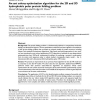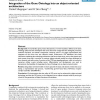BMCBI
2005
13 years 11 months ago
2005
Background: Exhaustive methods of sequence alignment are accurate but slow, whereas heuristic approaches run quickly, but their complexity makes them more difficult to implement. ...
BMCBI
2005
13 years 11 months ago
2005
Background: The protein folding problem is a fundamental problems in computational molecular biology and biochemical physics. Various optimisation methods have been applied to for...
BMCBI
2005
13 years 11 months ago
2005
Background: To standardize gene product descriptions, a formal vocabulary defined as the Gene Ontology (GO) has been developed. GO terms have been categorized into biological proc...
BMCBI
2005
13 years 11 months ago
2005
Background: A critical step in processing oligonucleotide microarray data is combining the information in multiple probes to produce a single number that best captures the express...
BMCBI
2005
13 years 11 months ago
2005
Background: Tissue microarray (TMA) technology has been developed to facilitate large, genome-scale molecular pathology studies. This technique provides a high-throughput method f...
BMCBI
2005
13 years 11 months ago
2005
Background: Cells react to changing intra- and extracellular signals by dynamically modulating complex biochemical networks. Cellular responses to extracellular signals lead to ch...
BMCBI
2005
13 years 11 months ago
2005
BMCBI
2005
13 years 11 months ago
2005
BMCBI
2005
13 years 11 months ago
2005
Background: We present a biological data warehouse called Atlas that locally stores and integrates biological sequences, molecular interactions, homology information, functional a...
BMCBI
2005
13 years 11 months ago
2005
Background: G- Protein coupled receptors (GPCRs) comprise the largest group of eukaryotic cell surface receptors with great pharmacological interest. A broad range of native ligan...




